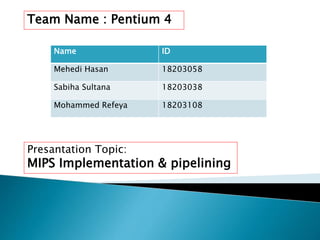
MIPS Implementation and pipelining
- 1. Team Name : Pentium 4 Name ID Mehedi Hasan 18203058 Sabiha Sultana 18203038 Mohammed Refeya 18203108 Presantation Topic: MIPS Implementation & pipelining
- 2. Contents: What is MIPS MIPS Calculations Features of MIPS MIPS Implementation • Logic Circuits • Processor Datapath • Organizations • MIPS Single-Cycle Datapath/Control • Components Pipelining
- 3. It is an older, obsolete measure of a computer's speed and power. MIPS measures roughly the number of machine instructions that a computer can execute in one second. What is MIPS? Million instructions per second
- 4. 2.4 cycles second CPI= * 10-6 cycles second CPI = 10-6 * clock rate CPI = 10-6 * Instructions second * 10-6MIPS = • MIPS does not take into account how many instructions must be executed in a program
- 5. MIPS specifies instruction execution rate MIPS does not take into account the capabilities of the instructions Thus, it is impossible to compare computers with different ISA using MIPS. MIPS is not constant, even on a single machine, depends on the application.
- 6. Logic circuits use two different values of a physical quantity, usually voltage, to represent the bulean values true (or 1) and false (or 0). Logic circuits can have inputs and they have one or more outputs that are, at least partially, dependent on their inputs a logic circuit can have multiple outputs. There are two basic types of logic circuitry: combinational circuitry and state circuitry 1. Combinational circuitry behaves like a simple function. The output of combinational circuitry depends only on the current values of its input. 2. State circuitry behaves more like an object method. The output of state circuitry does not just depend on its inputs — it also depends on the past history of its inputs. In other words, the circuitry has memory.
- 8. A processor's datapath is conceptually organized into two parts: •State elements hold information about the state of the processor during the current clock cycle. All registers are state elements. •Combinational logic determines the state of the processor for the next clock cycle. The ALU is combinational logic.
- 9. There are four major processor organizations: Single-cycle organization- It is characterized by the fact that each instruction is executed in a single clock cycle. It is not a realistic implementation — it requires two separate memories: one for data and one for instructions. Also, the clock cycle has to be made quite long in order for all of the signals generated in a cycle to reach stable values. Multicycle organization- This organization uses multiple clock cycles for executing each instruction. Each cycle does only a small part of the work required so the cycles are much shorter. Much of the circuitry is the same as the single-cycle implementation.
- 10. Pipelined organization- Like the multicycle organization, the pipelined organization uses multiple clock cycles for executing each instruction. By adding more state components for passing data and control signals between cycles, the pipelined organization turns the circuitry into an assembly line. After the first cycle of one instruction has completed you can start the execution of another instruction, while the first moves to its next cycle. Several instructions can be in different phases of execution at the same time. Register renaming organization - Register renaming is an extension of the pipelining idea. It deals with the data dependence problem for a pipeline — the fact that instructions in the pipeline produce data needed by other instructions in the pipeline
- 11. There are two basic types of logic components: combinational components and state components. A combinational component behaves like a simple function. Its outputs depend only on the current values of its inputs. A state component behaves more like an object method. Its output also depends on the past history of its inputs.
- 12. • IF – Instruction Fetch • ID – Instruction Decode • EX – Execution • MEM – Memory Access • WB – Write Back Pipelining